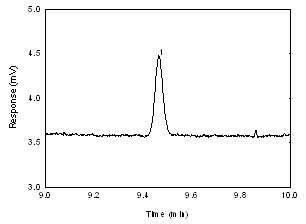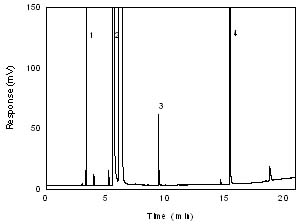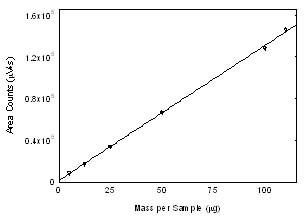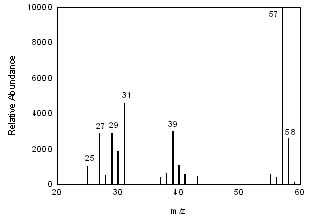|
| Method no.: |
PV2140 |
| |
|
| Control no.: |
T-PV2140-01-0410-CH |
| |
|
Target Concentration:
OSHA
PEL:
NIOSH REL
ACGIH TLV: |
2 ppm (5 mg/m3)
2 ppm (5
mg/m3) (Skin)
2 ppm (5 mg/m3) (4 ppm STEL)
(Skin)
0.5 ppm (skin) |
| |
|
| Procedure: |
Samples are collected by drawing a
known volume of air through glass sampling tubes containing coconut
shell charcoal. Samples are extracted with 95:5 methylene
chloride:methanol and analyzed by GC using a flame ionization
detector (GC/FID). |
| |
|
| Recommended sampling time and sampling
rate: |
200 min at 0.05 L/min (10 L) |
| |
|
| Reliable quantitation limit: |
0.07 mg/m3 |
| |
|
| Special Requirement: |
Samples should be refrigerated upon
receipt at the laboratory. |
| |
|
| Status of method: |
Partially validated method. This
method has been subjected to established evaluation procedures of
the Methods Development Team and is presented for information and
trial use. |
| |
|
| October 2004 |
Yogi Shah |
| |
|
| Please note: For problems
with accessibility in using figures and illustrations in this
method, please contact the author at (801) 233-4900. |
| |
|
Chromatography Team
Industrial Hygiene Chemistry
Division
OSHA Salt Lake Technical Center
Salt Lake City UT
84070-6406
|
1. General
Discussion
1.1 Background
1.1.1 History
This work was performed
because the method that SLTC uses for allyl alcohol, NIOSH
method 14021
,does not have tests for the effects of humid air on sampler
capacity, or for sample storage stability.
Results
presented in this method show that samples extracted with 1 mL
of 95:5 methylene chloride:methanol solution had good extraction
efficiencies averaging 98.7%. The retention efficiency results
showed no allyl alcohol on the back-up section of samples that
had been spiked with 100 µg of allyl alcohol and then had 10 L
of humid air drawn through them. The storage stability results
showed 89.1% recovery for samples stored for up to 14 days at
refrigerated temperature, and 83.9% at ambient temperature.
1.1.2 Toxic effects (This section is for information
only and should not be taken as the basis of OSHA
policy.)2
Allyl alcohol is not classified as carcinogen or a
suspect carcinogen by ACGIH. It may cause lung damage, skin
irritation and irritation to eyes. The oral LD50 is 64 mg/kg for
rats.
1.1.3 Workplace exposure3
Allyl alcohol is primarily used in manufacturing of
allyl compounds, war gases, resins and plasticizers. No
information on exposure is available.
1.1.4 Physical
properties and other descriptive information4,5
| CAS number: |
107-18-6 |
| IMIS6: |
0130 |
| molecular weight: |
58.08 |
| density: |
0.854 g/mL (25 °C) |
| melting point: |
-50 °C |
| boiling point: |
96-97 °C |
| appearance: |
colorless liquid |
| vapor pressure: |
2.67kPa @20 °C |
| odor: |
mustard like |
| molecular formula: |
C3H6O |
| solubility: |
miscible with water,
alcohol, chloroform |
| synonyms: |
2- propen-1-ol,
1-propenol-3, vinyl carbinol |
structural formula:

This method was evaluated according to the OSHA
SLTC "Evaluation Guidelines for Air Sampling Methods Utilizing
Chromatographic Analysis"7.
The Guidelines define analytical parameters, specify required
laboratory tests, statistical calculations and acceptance criteria.
The analyte air concentrations throughout this method are based on
the recommended sampling and analytical parameters.
1.2 Detection limit of the overall
procedure (DLOP) and reliable quantitation limit (RQL)
The
DLOP is measured as mass per sample and expressed as equivalent
air concentrations, based on the recommended sampling parameters.
Ten samplers were spiked with equal descending increments of
analyte, such that the highest sampler loading was 2.5 µg of allyl
alcohol. This is the amount spiked on a sampler that would produce
a peak at least 10 times the response for a sample blank. These
spiked samplers were analyzed with the recommended analytical
parameters, and the data obtained used to calculate the required
parameters (standard error of estimate and slope) for the
calculation of the DLOP. The slope was 1910 and the SEE was 138.4.
The RQL is considered the lower limit for precise quantitative
measurements. It is determined from the regression line parameters
obtained for the calculation of the DLOP, providing 75% to 125% of
the analyte is recovered. The DLOP and RQL were 0.22µg and 0.72µg,
respectively. The recovery at the RQL was 89%.
Table 1.2
Detection Limit of the Overall
Procedure
for Allyl alcohol
|
mass per
sample
(µg) |
area
counts
(µV-s) |
|
| 0 |
0 |
| 0.25 |
999 |
| 0.50 |
1258 |
| 0.75 |
1579 |
| 1.00 |
2138 |
| 1.25 |
2482 |
| 1.50 |
3034 |
| 1.75 |
3596 |
| 2.00 |
4052 |
| 2.25 |
4520 |
| 2.50 |
5027 |
|
 |
|
| Figure 1.2.1 Plot of
data to determine the DLOP/RQL for allyl alcohol (y =1910x +
220) |
|
Figure 1.2.2 is the chromatogram of the
RQL level.
 |
| Figure 1.2.2
Chromatogram of allyl alcohol at the RQL level. [key:(1)
allyl alcohol] | 2. Sampling Procedure
All safety practices
that apply to the work area being sampled should be followed. The
sampling equipment should be attached to the worker in such a manner
that it will not interfere with work performance or safety.
2.1 Apparatus
2.1.1 Samples are collected using a personal
sampling pump calibrated, with the sampling device attached, to
within ± 5% of the recommended flow rate.
2.1.2 Samples
are collected with 7-cm × 4-mm i.d.× 7-mm o.d. glass sampling
tubes packed with two sections (100/50 mg) of charcoal. The
sections are held in place with foam plugs with a glass wool
plug at the front. For this evaluation, commercially prepared
sampling tubes were purchased from SKC, Inc. (catalog no. 226-01
lot 2000). 2.2 Reagents
None required
2.3 Technique
2.3.1 Immediately before sampling break off the ends
of the flame-sealed tube to provide an opening approximately
half the internal diameter of the tube. Wear eye protection when
breaking tube ends. Use tube holders to minimize the hazard of
broken glass. All tubes should be from the same lot.
2.3.2 The smaller section of the adsorbent tube is used
as a back-up and is positioned nearest the sampling pump. Attach
the tube holder to the sampling pump so that the adsorbent tube
is in an approximately vertical position with the inlet facing
down during sampling. Position the sampling pump, tube holder,
and tubing so they do not impede work performance or safety.
2.3.3 Draw air to be sampled directly into the inlet of
the tube holder. The air being sampled is not to be passed
through any hose or tubing before entering the sampling tube.
2.3.4 After sampling for the appropriate time, remove
the adsorbent tube and seal it with plastic end caps. Seal each
sample end-to-end with an OSHA-21 form as soon as possible.
2.3.5 Submit at least one blank sample with each set of
samples. Handle the blank sample in the same manner as the other
samples except draw no air through it.
2.3.6 Record
sample air volumes (liters), sampling time (minutes), and
sampling rate (L/min) for each sample, along with any potential
interferences on the OSHA-91A form.
2.3.7 Submit the
samples to the laboratory for analysis as soon as possible after
sampling. If delay is unavoidable, store the samples at
refrigerator temperature. Ship any bulk samples separate from
the air samples. 2.4 Extraction efficiency
The extraction efficiency was determined by spiking
charcoal tubes (SKC, lot 2000) with allyl alcohol at 0.1 to 2
times the target concentration. These samples were stored
overnight at ambient temperature and then extracted for 30 minutes
with shaking, and analyzed. The mean extraction efficiency over
the studied range was 98.7%. The wet extraction efficiency was
determined at 1 times the target concentration by liquid spiking
the analyte onto charcoal tubes which had 10 L humid air (absolute
humidity of 15.9 mg/L of water, about 80% relative humidity at
22.2 °C) drawn through them. The mean recovery for the wet samples
was 97.8%.
Table 2.4
Extraction Efficiency (%) of Allyl
Alcohol
|
level
|
sampler number
|
|
x
target
concn |
Fg per
sample |
1 |
2 |
3 |
4 |
5 |
6 |
mean |
|
| 0.1 |
0.5 |
98.5 |
103.5 |
101.7 |
99.8 |
98.3 |
95.7 |
99.6 |
| 0.25 |
12.5 |
100.1 |
98.9 |
96.6 |
96.6 |
99.2 |
99.5 |
98.5 |
| 0.5 |
25 |
102.1 |
97.6 |
103.0 |
100.1 |
103.0 |
101.5 |
101.2 |
| 1.0 |
50 |
96.8 |
99.8 |
97.4 |
93.2 |
98.7 |
96.9 |
97.1 |
| 2.0 |
100 |
97.7 |
97.9 |
96.9 |
96.0 |
96.0 |
98.1 |
97.1 |
|
|
|
|
|
|
|
|
|
| 1.0
(wet) |
50 |
97.8 |
98.8 |
97.3 |
96.8 |
97.6 |
98.2 |
97.8 |
|
2.5 Retention
efficiency
Six charcoal tubes were spiked with 100µg of
allyl alcohol, in the front section of the tubes, and allowed to
equilibrate for 6 h. The tubes had 10 L humid air (absolute
humidity of 15.9 mg/L of water, about 80% relative humidity at
22.2 °C) pulled through them at 0.05 L/min. The samples were
extracted and analyzed. The mean retention recovery was 97.4%.
There was no analyte found on the back-up section of any of the
tubes.
Table 2.5
Retention Efficiency (%) of Allyl
Alcohol |
|
| |
sample number
|
| section |
1 |
2 |
3 |
4 |
5 |
6 |
mean |
|
| front
of spiked tube |
96.1 |
95.5 |
97.5 |
97.9 |
100.9 |
95.9 |
97.4 |
| rear of
spiked tube |
0.0 |
00.0 |
00. |
00.0 |
00.0 |
00.0 |
00.0 |
| total |
96.1 |
95.5 |
97.5 |
97.9 |
100.9 |
95.9 |
97.4 |
|
2.6 Sample
storage
Fifteen charcoal tubes were each spiked with 50µg
of allyl alcohol. They were allowed to equilibrate for 6 h, then
10 L of air (absolute humidity of 15.9 mg/L of water about 80%
relative humidity at 22.2°C), were drawn through them. Three
samples were analyzed immediately, and the rest were sealed. Six
were stored at room temperature (23 °C), while the other six were
stored at refrigerated temperature (4 °C). Three samples stored at
room temperature and three samples stored at refrigerated
temperature were analyzed after 7 days and the remaining six after
14 days. The amounts recovered indicate acceptable storage
stability for the time period studied. Refrigerated samples show
better recovery, therefore, it is advised to store samples at
refrigerated temperature.
Table
2.6
Storage Test for Allyl Alcohol (% Recovery )
|
| time (days) |
ambient
storage |
refrigerated storage |
|
| 0 |
92.9 |
92.5 |
97.9 |
|
|
|
| 7 |
85.7 |
87.2 |
87.0 |
88.1 |
90.2 |
88.2 |
| 14 |
81.0 |
83.9 |
86.7 |
90.1 |
88.9 |
88.3 |
|
2.7 Recommended
air volume and sampling rate
Based on the data collected
in this evaluation, 10 L air samples should be collected at a
sampling rate of 0.05 L/min for 200 minutes.
2.8
Interferences (sampling)
2.8.1 There are no known compounds which will
severely interfere with the collection of allyl alcohol.
2.8.2 Suspected interferences should be reported to the
laboratory with submitted samples.
3. Analytical
Procedure
Adhere to the rules set down in your Chemical
Hygiene Plan. Avoid skin contact and inhalation of all chemicals and
review all appropriate MSDSs.
3.1 Apparatus 3.1.1 A gas chromatograph
equipped with an FID. An Agilent 6890 plus series Gas
chromatograph equipped with a 7683 Automatic Sampler was used in
this evaluation.
3.1.2 A GC column capable of separating allyl
alcohol from the extraction solvent, internal standard, and any
potential interference. A Phenomenex 60-m × 0.32-mm i.d. ZB-WAX
(1.5-Fm df ) capillary column was used in this evaluation.
3.1.3 An electronic integrator or some other suitable
means of measuring peak areas. A Waters Millennium32 Data System
was used in this evaluation.
3.1.4 Glass vials with poly
(tetrafluoroethylene)-lined caps. Two-mL vials were used in this
evaluation.
3.1.5 A dispenser capable of delivering 1.0
mL of extraction solvent to prepare standards and samples. If a
dispenser is not available, a 1.0-mL volumetric pipet may be
used.
3.1.6 Volumetric flasks – 10-mL and other
convenient sizes for preparing standards.
3.1.7
Calibrated 10-µL or 20-µL syringe for preparing standards.
3.1.8 A mechanical shaker. An Eberbach mechanical shaker
was used in this evaluation. 3.2 Reagents
3.2.1 Allyl alcohol, reagent grade. Aldrich 99.5%,
(lot 09427CS) was used in this evaluation.
3.2.2
Methanol, reagent grade. Fisher 99.8%, (lot 020390) was used in
this evaluation.
3.2.3 Methylene chloride, HPLC grade.
Fisher 99.7%, (lot 034459) was used in this evaluation.
3.2.4 2-Ethyl-1-hexanol, reagent grade, internal
standard. Aldrich 99.7%, (lot 01319TR) was used in this
evaluation.
3.2.5 The extraction solvent solution was
methylene chloride:methanol (95:5) with 1.25µL/mL of
2-ethyl-1-hexanol as internal standard 3.3 Standard
preparation
3.3.1 At least two separate stock standards should
be prepared. Prepare a stock standard by injecting 3µL of allyl
alcohol into a 10-mL volumetric flask containing the extraction
solvent. Dilute this stock standard 1:5 to prepare a working
standard equivalent to the PEL.
3.3.2 Bracket sample
concentrations with standard concentrations. If upon analysis,
sample concentrations fall outside the range of prepared
standards, prepare and analyze additional standards to confirm
instrument response, or dilute high samples with extraction
solvent and reanalyze the diluted samples. 3.4 Sample
preparation
3.4.1 Remove the plastic end caps from the sample
tubes and carefully transfer the adsorbent sections to separate
2-mL vials. Discard the glass tube, urethane foam plug and glass
wool plug.
3.4.2 Add 1.0 mL of extracting solvent to
each vial.
3.4.3 Immediately seal the vials with
poly(tetrafluoroethylene)-lined caps.
3.4.4 Shake the
vials on a shaker for 30 minutes. 3.5 Analysis
3.5.1 Gas chromatographic conditions
GC conditions
|
|
| column: |
initial 70 °C,
hold 4 min, program temperature at 10 °C/min to 220 °C,
hold 2 min |
| zone
temperatures: |
250 °C
(injector)
250 °C (detector) |
| run time: |
21 min |
| column gas
flow: |
2.0 mL/min
(hydrogen) |
| injection size: |
1.0µL (10:1
split) |
| column: |
Phenomenex -60-m ×
0.32-mm i.d. capillary ZB-WAX with 1.5-FFm df |
| retention times: |
5.6, 6.0 min
solvent
9.4 min (allyl alcohol)
15.2 min (2-ethyl
-1-hexanol) |
|
|
FID conditions
|
|
| hydrogen flow: |
30 mL/min |
| air flow: |
400 mL/min |
| makeup flow: |
25 mL/min
(nitrogen) |
 |
| Figure 3.5.1
Chromatogram obtained at the target level with the
recommended conditions. [key: (1) impurity; (2) solvent
(3) allyl alcohol, and (4)
2-ethyl-1-hexanol] |
3.5.2 Peak areas are measured by an integrator or
other suitable means.
3.5.3 An internal standard (ISTD)
calibration method is used. A calibration curve can be
constructed by plotting response of standard injections versus
micrograms of analyte per sample. Bracket the samples with
freshly prepared analytical standards over the range of
concentrations.
 |
Figure 3.5.3.
Calibration curve for allyl alcohol.
(y =1291x
+1809) | 3.6 Interferences (analytical)
3.6.1 Any compound that produces a GC response and
has a similar retention time as the analyte is a potential
interference. If any potential interference were reported, they
should be considered before samples are extracted. Generally,
chromatographic conditions can be altered to separate an
interference from the analyte.
3.6.2 When necessary, the
identity or purity of an analyte peak can be confirmed by
GC-mass spectrometry. Figure 3.6.2 is a mass spectrum of allyl
alcohol.
 |
| Figure 3.6.2 Mass
spectrum of allyl
alcohol | 3.7 Calculations
3.7.1 The amount of analyte per sampler is obtained
from the appropriate calibration curve in terms of micrograms
per sample, uncorrected for extraction efficiency. This total
amount is then corrected by subtracting the total amount (if
any) found on the blank. The air concentration is calculated
using the following formulas.
|
|
| where: |
CM is concentration
by weight |
| M is micrograms
per sample |
| V is liters of
air sampled |
| EE is
extraction efficiency, in decimal
form | |
|
|
| where: |
CV is concentration
by volume (ppm) |
| M is 24.46 (molar
volume at NTP) |
| V is
concentration by weight |
| EE is
molecular weight
(58.08) | | 4. Recommendations for Further Study
Collection, reproducibility, and other detection limit
studies need to be performed to make this a fully validated method.
References
1. NIOSH Method
1402, .www.cdc.gov/niosh, (accessed October 2003).
2. 2004
TLV and BEIs, Threshold Limit Values for Chemical Substance and
Physical Agents, American Conference of Governmental Industrial
Hygienists, (ACGIH): Cincinnati, OH, 2004.
3. O’Neil,M., The
Merck Index, 13th ed., Merck & Co. Inc.: Whitehouse Station, NJ,
2001, p 297.
4. 2004 TLV and BEIs, Threshold Limit Values
for Chemical Substance and Physical Agents, American Conference of
Governmental Industrial Hygienists, (ACGIH): Cincinnati, OH, 2004.
5. O’Neil,M., The Merck Index, 13th ed., Merck & Co.
Inc.: Whitehouse Station, NJ, 2001, p 297.
6. OSHA Chemical
Sampling Information, www.osha.gov, (accessed October 2003).
7. Burright, D.; Chan, Y.; Eide, M.; Elskamp, C.; Hendricks,
W.; Rose, M. C. Evaluation Guidelines For Air Sampling Methods
Utilizing Chromatographic Analysis; OSHA Salt Lake Technical Center,
U.S. Department of Labor, Salt Lake City, UT, 1999.
|
| |
| |

